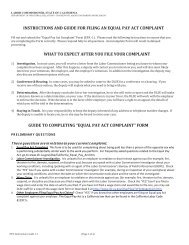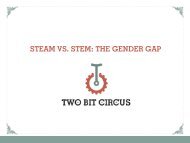EQUITY
2eGXKK2
2eGXKK2
You also want an ePaper? Increase the reach of your titles
YUMPU automatically turns print PDFs into web optimized ePapers that Google loves.
TABLE<br />
O*NET JOB ZONES<br />
A1<br />
JOB<br />
ZONE<br />
1<br />
Little<br />
2<br />
Some<br />
3<br />
Medium<br />
4<br />
Considerable<br />
5<br />
Extensive<br />
Preparation<br />
Needed Education Related Experience Job Training Job Zone Examples<br />
or none Some of these<br />
occupations may<br />
require a high<br />
school diploma or<br />
GED certificate.<br />
These occupations<br />
usually require a<br />
high school diploma.<br />
Most occupations<br />
in this zone<br />
require training in<br />
vocational schools,<br />
related on-the-job<br />
experience, or an<br />
associate degree.<br />
Most of these<br />
occupations<br />
require a four-year<br />
bachelor’s degree,<br />
but some do not.<br />
Most of these<br />
occupations require<br />
graduate school. For<br />
example, they may<br />
require a master’s<br />
degree, and some<br />
require a Ph.D., M.D.,<br />
or J.D. (law degree).<br />
Source: National Center for O*NET Development (2008).<br />
Little or no previous work-related<br />
skill, knowledge, or experience<br />
is needed for these<br />
occupations. For example, a<br />
person can become a waiter<br />
or waitress even if he/she<br />
has never worked before.<br />
Some previous work-related<br />
skill, knowledge, or experience<br />
is usually needed. For<br />
example, a teller would benefit<br />
from experience working<br />
directly with the public.<br />
Previous work-related skill,<br />
knowledge, or experience<br />
is required for these occupations.<br />
For example, an<br />
electrician must have completed<br />
three or four years of<br />
apprenticeship or several<br />
years of vocational training,<br />
and often must have passed<br />
a licensing exam, in order to<br />
perform the job.<br />
A considerable amount of<br />
work-related skill, knowledge,<br />
or experience is needed<br />
for these occupations.<br />
For example, an accountant<br />
must complete four years of<br />
college and work for several<br />
years in accounting to be<br />
considered qualified.<br />
Extensive skill, knowledge,<br />
and experience are needed<br />
for these occupations. Many<br />
require more than five years<br />
of experience. For example,<br />
surgeons must complete<br />
four years of college and an<br />
additional five to seven years<br />
of specialized medical training<br />
to be able to do their job.<br />
Employees in these occupations<br />
need anywhere<br />
from a few days to a few<br />
months of training. Usually,<br />
an experienced worker<br />
could show you how to do<br />
the job.<br />
Employees in these occupations<br />
need anywhere<br />
from a few months to<br />
one year of working with<br />
experienced employees. A<br />
recognized apprenticeship<br />
program may be associated<br />
with these occupations.<br />
Employees in these occupations<br />
usually need one<br />
or two years of training<br />
involving both on-the-job<br />
experience and informal<br />
training with experienced<br />
workers. A recognized apprenticeship<br />
program may<br />
be associated with these<br />
occupations.<br />
Employees in these occupations<br />
usually need several<br />
years of work-related<br />
experience, on-the-job<br />
training, and/or vocational<br />
training.<br />
Employees may need<br />
some on-the-job training,<br />
but most of these occupations<br />
assume that the person<br />
will already have the<br />
required skills, knowledge,<br />
work-related experience,<br />
and/or training.<br />
These occupations involve following<br />
instructions and helping<br />
others. Examples include<br />
taxi drivers, amusement and<br />
recreation attendants, counter<br />
and rental clerks, nonfarm<br />
animal caretakers, continuous<br />
mining machine operators,<br />
and waiters/waitresses.<br />
These occupations often involve<br />
using your knowledge<br />
and skills to help others. Examples<br />
include sheet metal<br />
workers, forest fire fighters,<br />
customer service representatives,<br />
physical therapist aides,<br />
salespersons (retail), and<br />
tellers.<br />
These occupations usually<br />
involve using communication<br />
and organizational skills to coordinate,<br />
supervise, manage,<br />
or train others to accomplish<br />
goals. Examples include food<br />
service managers, electricians,<br />
agricultural technicians, legal<br />
secretaries, occupational therapy<br />
assistants, and medical<br />
assistants.<br />
Many of these occupations<br />
involve coordinating, supervising,<br />
managing, or training<br />
others. Examples include<br />
accountants, sales managers,<br />
database administrators,<br />
teachers, chemists, art directors,<br />
and cost estimators.<br />
These occupations often involve<br />
coordinating, training,<br />
supervising, or managing the<br />
activities of others to accomplish<br />
goals. Very advanced<br />
communication and organizational<br />
skills are required.<br />
Examples include librarians,<br />
lawyers, sports medicine<br />
physicians, wildlife biologists,<br />
school psychologists, surgeons,<br />
treasurers, and controllers.<br />
40 NARROWING THE WAGE GAP BY IMPROVING WOMEN’S ACCESS TO GOOD MIDDLE-SKILL JOBS




